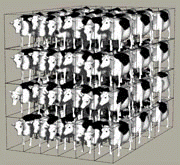Department of Animal Science
Date of this Version
1986
Abstract
Data from a four-generation crossbreeding experiment with Hereford, Angus and Shorthorn cattle were analyzed. Individual, maternal, and grand-maternal additive and heteroic effects on the composite trait of calf weight weaned per cow exposed to breeding and its component traits were evaluated. The parameter estimates were than used to project performance at equilibrium under rotation crossbreeding. The average of two-breed cross rotations is expected to increase calf weight weaned per cow exposed by 18 percent above the average of the three straight breeds. The three-breed cross rotation is expected to increase calf weight weaned per cow exposed by 23 percent above the average of the three straight breeds. For the average of all two-breed cross rotations combined with a terminal sire crossbreeding system, the expected increase in calf weight weaned per cow exposed above the average of all straight breeds is 24 percent. On the same basis, the expectation for a three-breed cross rotation combined with a terminal sire crossbreeding system is 28 percent.


Comments
Published in 3rd World Congress on Genetics Applied to Livestock Production, edited by Gordon E. Dickerson and Rodger K. Johnson, 4 vols. (Lincoln: University of Nebraska Institute of Agriculture and Natural Resources, 1986). Copyright © 1986 Board of Regents University of Nebraska.